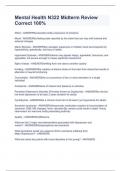Exam (elaborations)
ATI Lewis Chapter 58 Chronic Neurologic Problems Questions and correct answers graded+ year 2022/2023
- Course
- Institution
ATI Lewis Chapter 58 Chronic Neurologic Problems Questions and correct answers graded+ year 2022/2023
[Show more]












